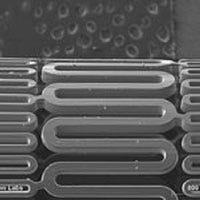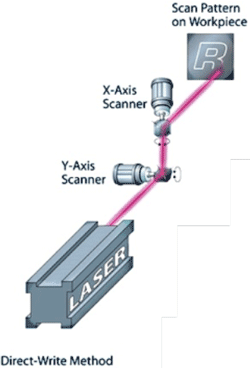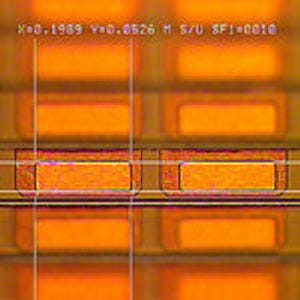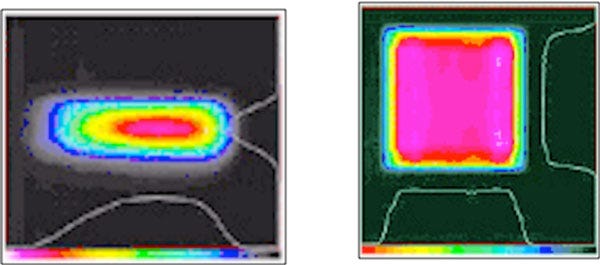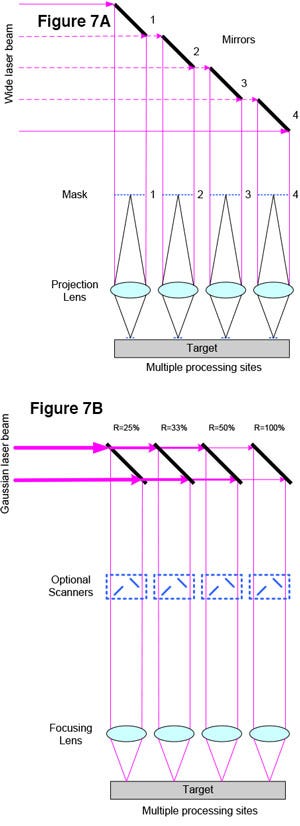January 26, 2016
It can be a complex calculus to weigh the pros and cons of various laser technologies for polymer micromachining. Here is some guidance on the subject.
For the past few decades, excimer lasers have been widely used for the laser micromachining of polymers in the life science industry. With the recent advances of high power ultrafast lasers, these new laser sources are being considered for certain polymer machining applications. The selection criteria for the most optimum laser source are not trivial, as many different considerations must be taken into account. Process quality, process throughput, capital cost, ease of system integration, operating cost, maintenance, and serviceability are examples of the selection criteria. This article intends to explain the benefits, advantages, and limitations of the various laser technologies suited for the laser micromachining of polymers.
Introduction
Excimer lasers have been widely used for many polymer laser micromachining applications, ranging from microelectronics, medical, life sciences, automotive, printing, and other industrial applications. Excimer lasers produce high energy UV radiation in a range of wavelengths; the ones most commonly used are 308nm (XeCl gas), 248nm (KrF gas) and 193nm (ArF gas). They are suited for machining polymers, which exhibit good absorption at these wavelengths. Excimer laser technologies matured in the 1980s, primarily as a result of advances in UV and deep UV laser photolithography for the semiconductor industry. Using similar technology, excimer lasers were then developed for use in micromachining. These pulsed lasers produce high average UV power from a few to hundreds of watts at relatively low repetition rates, and from tens of pulses per second up to a few thousands of pulses per second. Each pulse duration can range from a few nanoseconds to hundreds of nanoseconds and their pulse energy range from a few millijoules to a few joules. The UV laser beams generated by these excimer lasers are generally incoherent, wide and multimode.
Many polymer materials, such as polycarbonate, polyesters, and polyimide, can be laser-machined using excimer lasers at 308nm or 248 nm. There are other polymers, however, such as nylon, Teflon and other fluoro- based polymers that do not absorb sufficiently at these wavelengths. For these materials, shorter wavelengths, 193 nm, are required. Most polymer materials only require energy densities of a few tenths of joules per square centimeters to a few joules per square centimeter for optimum ablation rate at those UV wavelengths.
Stop by Resonetics' booth (#2147) at MD&M West, February 9-11 at the Anaheim Convention Center in Anaheim, CA. |
Lamp-pumped and diode-pumped solid-state lasers can also be used to produce UV laser radiation for machining polymers. These lasers generate fundamental near-infrared wavelength around 1 micron, which can be converted to visible or UV wavelengths using harmonic frequency generation crystals. A wavelength of 355 nm is now available in tens of watts using third-harmonic non-linear crystals. Only a limited number of polymer materials, such as polyimide, exhibit enough optical linear absorption at 355 nm to be useful for micromachining. 266 nm wavelength lasers are also available commercially using fourth-harmonics conversion, but they are limited to only of a few watts of maximum average power. Their performance and energy output are limited due to gradual degradation of the harmonics crystals at high pulse energy at this short wavelength.
Ultrafast lasers, which have recently become commercially available, offer high enough pulse energy, average power and reliability for use in a wide range of industrial laser micromachining applications. These lasers are characterized by pulse width from tens of picoseconds down to the hundreds of femtoseconds. Fundamental wavelengths are typically in the near infrared (0.8, 1 or 1.5 microns are typical). Frequency conversion with harmonics generation produce green (532nm) and UV (355nm) wavelengths. Lasers with average power of tens of watts are now commercially available, and reports have recently been published of lasers that produce hundreds of watts average power. It is important to note that these high average powers are often obtained by increasing the pulse repetition rates as opposed to the pulse energy. Pulse repetition rates of these high average power femto and pico-second lasers are typically hundreds of kilohertz up to a few megahertz. Ultrafast lasers with pulse energies of tens of microjoules to millijoules that can be used for micromachining are now available.
Micromachining of polymer materials is possible with ultrafast lasers at long wavelengths even though these polymer materials are mostly optically transparent at these long wavelengths where little or no linear optical absorption occurs with traditional slower pulsed lasers. With ultrafast lasers, the peak power density is so high that non-linear absorption phenomena take place, such as multi-photo absorption and Coulomb interaction breakdown. These non-linear absorption effects take place in the small focused beam over the very short duration of the laser pulse width. During the short laser pulse, most of the laser energy is used to break the polymer chemical chains and it has no time to dissipate into molecular vibrations that would heat the material. Most of the energy in these short pulses is used to break the chemical bonds and ablate the material. This results in clean laser cuts often refer to as "cold ablation," where material is removed with very limited heat effects observed. This cold ablation effect has its limitation, however. When the pulse repetition rate is increased, ultrafast laser pulses can also heat the polymer material and local heat effects become observable. This limits the usable laser repetition rates of these lasers in polymer materials to typically 100 kHz or less, much less than their typical maximum available rates. Fortunately, ultrafast lasers are often equipped with a pulse picker, a high-speed optical gate device that enables laser pulses pass through on demand. This pulse picker gives the user a way to effectively reduce the pulse repetition rate of the laser to an acceptable rate where no heat effects are observed. This technique is, however, wasteful and reduces utilization of the available laser power.
Optical Configurations
A. Ultrafast Lasers
Ultrafast lasers produce high quality Gaussian laser beam profiles that can be focused on the target to a spot size from a few microns to tens or hundreds of microns in diameter. The spot diameter and laser pulse energy must be carefully chosen so that the energy density on target rises above the ablation threshold of the material (i.e. energy density above which ablation begin). If the beam diameter is too large, the energy density on target is too small and no ablation occurs. Conversely, if the spot is too small or the energy is too large, excess energy is not efficiently used for etching and is deposited on the material where it is converted to heat that can melt surrounding material and reduce cut quality.
In some applications, the target is moved under the laser beam with high-speed stages. This is the case, for instance, for laser machining of bioabsorbable scaffolds (Fig. 1). In this case, a polymer tube is clamped on the axis of a rotary stage and translated on top of a linear stage parallel to the tube axis.
|
Fig. 1 Bioabsorbable scaffold |
In other applications, the target is fixed and the laser beam scans the pattern at high speed. In that case, the beam passes through an optical galvanometer scanner and a scan lens to steer and focus the beam at high speed on the target. This configuration is typically used to micro-machine a pattern on a flat polymer sheet or polymer layers deposited on a wafer. Vector scanning is the most common technique used to laser machine a pattern on a flat substrate. Scan speed and laser pulse repetition rates must be carefully chosen to achieve proper beam overlap. With insufficient beam overlap in the scan direction (too fast scan speed or too low pulse repetition rates), a scalloping effect becomes visible, resulting in jagged edges. Conversely, excessive scan overlap with too high repetition rates or too slow scan speeds can result in excess heat effects. With a galvanometer scanner (Fig. 2), linear scan speeds are limited to a maximum few meters per second and even slower speeds in tight radius turns. This limits the maximum pulse repetition rates that can be used in a vector scan patterns with these lasers. In this case, the maximum internal rates achievable from the laser cannot be utilized, limiting the process throughput and wasting available laser power.
There are different techniques for overcoming the mechanical and process speed limitations and for better utilization of the available laser power. Laser pulse multiplexing is a method to split the laser pulse train into multiple beam paths using a high speed optical switching device. In this case, the laser pulses are distributed sequentially into multiple beam paths, effectively reducing the pulse repetition rate in each. This pulse multiplexing method increases the complexity and cost of the system, but it increases the overall system throughput by better utilization of high laser pulse repetition rates.
|
Fig. 2 Galvanometer scanner |
Another technique to take advantage of the high repetition pulse rates available with these ultrafast lasers is to use a high-speed scanner such as polygon scanner (Fig. 3). These high speed scanners overcome the speed limitations of galvanometer scanners. Polygon scanners are multi-faceted polygon mirrors that spin continuously at high speed to produce a linear scan line. The beam is turned on and off at high speed where material has to be etched. The object is translated or rotated slowly in the direction perpendicular to the polygon scan line to expose the entire surface of the sample. This technique uses raster laser scanning and the laser beam is turned on and off during the raster scan to etch the pattern on the target. Polygon scanners can be used to steer the beam in raster mode with speeds from tens to hundreds of meters per second. This technique can be very efficient for high-density patterns where the etched pattern covers a large portion of the total sample area. The laser can be used at very high repetition rates because of the very high scan raster speed. For low-density patterns, however, this technique is not very efficient because the laser is turned off most of the time while the system raster scans over the entire area of the sample. The other critical aspect of this technique is the scan-to-scan overlap needs to be very well controlled to avoid stitching errors between adjacent scans. Raster scanning with a polygon scanner is a technique well suited for work such as removing a large area pattern of polymer coating on a flat substrate. It can also be used to remove polymer materials and coatings off tubular parts. In this case, the polygon scans at high speed a line along the axis of the tube, and the tube is slowly rotated to expose the entire tube circumference to the laser.
|
Fig. 3 Polygon Scanner |
B. Excimer Lasers
Unlike ultrafast lasers, which use a direct laser beam writing technique, excimer lasers produce wide multimode UV laser beams at high energy and low repetition rates. The large output beam profiles of the excimer lasers are well suited for mask projection (Fig 4). With this technique, the excimer laser beam is not directly focused on the target. It is first used to illuminate a patterned mask. Mask patterns are typically etched in free standing metal foils or etched into thin metal coatings on a UV-transparent fused silica substrate. The image produced by the illuminated patterned mask is projected on the target at reduced magnification using a projection lens. The demagnification is selected to achieve an energy density (called fluence) on target. This fluence must be higher than the ablation threshold of the material, typically a few tens to hundreds of milijoules per square centimeter for most polymer materials. The higher the demagnification of the mask pattern on the target, the larger the fluence on the target but the smaller the image size. The demagnification must therefore be carefully selected to achieve maximum throughput by producing a beam on target with fluence to produce optimum etch ablation rate and with largest possible size to be exposed.
|
Fig.4 Excimer Laser Mask Projection |
Furthermore, the shape of the excimer laser beam can be customized to efficiently illuminate the mask pattern. This, of course, is very dependent on the application. For instance, micromachining of polymer layers from wires and tubes is optimized with long illumination lines to achieve high throughput. The narrow line is aligned to the axis of the tube or wire. The line remains in focus if the width of the line is small compared to the tube radius of curvature. The tube or wire is rotated around its axis to expose all sides to the laser beam. Another example of using long line illumination is to illuminate the pads aligned along a line at the edge of a die (Fig. 5). All the pads that fall inside the field of the long rectangular laser beam can be etched simultaneously in one field.
|
Fig. 5 Die pad ablation |
The raw laser beam of the excimer lasers have a quasi-normal shaped intensity distribution profile. Homogenization techniques (Fig. 6) are often used to convert the excimer laser beam intensity distribution from quasi Gaussian to flat top distribution and make most efficient use of all energy available in the beam for imaging a large mask pattern. These homogenization techniques increase beam utilization and process throughput, but also increase system cost and complexity.
Capital Costs and Operating Costs
When considering capital acquisition for laser micromachining, both capital costs and operating costs of the systems must be carefully evaluated and the costs of different technologies must be compared. The cost of ultrafast lasers is expected to decrease in the coming years, by scale of economy, in part due to their wider acceptance and use in large markets such as engine injection nozzle drilling and medical surgery applications. This will have a positive impact in other markets using these lasers. This cost reduction has not yet occurred, however, and ultrafast lasers are still more expensive today than comparable excimer lasers. The cost of excimer lasers normalized to their average output power is still significantly lower than the comparative cost of picosecond or femtosecond lasers normalized to their average output power.
|
Fig. 6 Excimer Laser Beam Profile (raw (left) and after homogenizer (right)). |
Initial cost of the laser system must be amortized over a period of time and number of parts manufactured. The overall system throughput is very dependent on the specific application. With proper system engineering and design, high beam utilization and duty cycle can be achieved. In this case, the throughput is linearly correlated to the laser average output power.
The laser output power, however, cannot always be fully utilized due in part to process limitations and other design limitations. Very often, the technology that wins is the one that can make the best utilization of the power available from the laser directly for the micromachining process. Optimization of the laser process, as well as optimization of the system engineering and design, are critical intertwined factors to achieve highest possible beam utilization and duty cycle in manufacturing.
If, for instance, the laser output power is much higher than what the process can accommodate, a large portion of the available laser power is wasted. One system design technique that can be used to increase throughput and efficiency of such a system is to split the laser beam into multiple beams and process multiple parts in parallel. With this laser splitting technique, the effective throughput of the laser system can be increased. The system complexity and cost also increase, but considering that the laser is often the most expensive component of the overall system cost, the capital cost per unit part manufactured is generally lower.
Excimer lasers are often split by geometrically dividing the rectangular beam into smaller beamlets (Fig. 7a). On the other hand, ultrafast lasers are split with the use of optical beamsplitters that preserve the spatial quality of the beam profile (Fig. 7b).
|
Fig. 7 Split Beam Approach, (a) for wide beam of an excimer laser; (b) for a Gaussian beam (DPSS, ultrafast, RF-CO2 lasers). |
Compared to the initial capital cost, the operation cost of most excimer lasers typically exceeds the operating cost of ultrafast lasers. The operating cost of excimer lasers is often dominated by refurbishment cost of the laser gas vessel. Excimer laser vessels and electrodes corrode by chemical interactions between corrosive excimer gases and materials inside the vessel, and this creates particles floating inside the vessel. The vessel typically needs to be refurbished after approximately one billion pulses. Vessel exchange can be performed during scheduled downtime. Thyratron switches used to generate the discharge also have a finite life and need to be replaced. New solid state switches that do not wear are now available for low power and high repetition rate excimer lasers. UV laser resonator optics and UV beam delivery optics that degrade over time under UV exposure need to be replaced, typically after few hundreds of millions of shots; these can significantly increase the system operating costs. Finally, gas replacement has to be performed every few tens of millions of shots; this has a smaller contribution to the operating cost of the system. With 193 nm excimer lasers, purging of the beam delivery path with a gas (usually, nitrogen) less absorptive than air is often needed. All these consumables required to operate a UV excimer laser require more complex infrastructure and support capabilities, add more downtime, and incur higher maintenance costs.
Ultrafast lasers, on the other hand, require fewer consumables and much less maintenance. Typically, their diode pumps operate continuously for tens of thousands of hours before they degrade enough to require replacement. Harmonic generator crystals and other optical components may also contribute to operating cost of these lasers, but are relatively modest when amortized over their lifetime. Another advantage of ultrafast lasers is their use at longer wavelengths. At those longer wavelengths, optical components both in the laser itself and in the beam delivery are much more durable than at the shorter wavelength of the UV excimer lasers.
|
Fig. 8 Microhole array |
Although operating and maintenance costs of ultrafast lasers can be substantially lower than UV excimer lasers, these costs must be normalized to the system throughput for proper comparison. In cases where the throughput of the excimer laser is much higher than a similar system with ultrafast lasers, the operating cost per part of the excimer can still be significantly less. This is the case, for example, for high density pattern such as polymer fluidic filters (Fig. 8) with a high density of small diameter holes in a dense array pattern. The larger available average power and larger beam size of excimer lasers enable parallel micromachining of more holes. Large field mask imaging enables rapid processing of larger area of the array. Processing of this type of dense hole arrays with ultrafast lasers would be much slower since, in this case, each hole is written directly and sequentially with the laser beam.
Conclusion
Both excimer lasers and ultrafast lasers are appropriate sources well suited for micromachining a variety of polymer materials for various applications and industries. Flat substrates, sheets, tubes or other three dimensional shaped objects can be micro-machined with these lasers. The laser system design and integration is critical to achieve high throughput for economical manufacturing. High beam power utilization and high laser pulse duty cycles are necessary to make the process economically feasible. Both capital cost and operating cost of the laser must be carefully evaluated and compared to identify the most economical technology to use in high volume manufacturing.
Excimer lasers are available at much higher average power levels than ultrafast lasers, and their initial cost is lower, especially if normalized to their power output. However, they require more maintenance and have typically higher operating cost. Excimer lasers can achieve much higher throughput for high volume manufacturing especially for high density patterns. For low density patterns such as machining a few holes in each part, the choice is often more complex. High repetition rate, low power excimer lasers are now available with low operating costs and can be used economically for these applications. Ultrafast lasers may also be a good choice for these types of applications because of their low maintenance, few consumables and low operating cost. The initial investment cost of these lasers is still much higher, but expected to decline in the future.
In practice, each application much be considered on a case-by-case basis, and each technology must be evaluated and compared on its own merit based on process quality, throughput, capital cost and operating cost of the laser and the overall system. This evaluation requires close collaboration between the laser process engineer, the system design engineer and the manufacturing engineer to find the optimum solution.
References
1. D. Basting et al., Riken Review No 43 (January 2002), LPM 2001, "History and future prospects of excimer laser technology".
2. L. Cerami et al., "Femtosecond laser micromachining", Springer, Scottish Graduate Series 2013, pp 287-321.
3. 3. B. Jaeggi et al., "High-throughput and high-precision laser micromachining with ps-pulses in synchronized mode with a fast polygon line scanner." Proc. SPIE 8967, Laser Applications in Microelectronic and Optoelectronic Manufacturing (LAMOM) XIX, 89670Q (March 6, 2014).
Pascal Miller, PhD is the vice president, systems engineering at Resonetics.
About the Author(s)
You May Also Like
